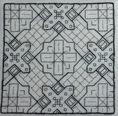BLACKWORK : TECHNIQUES | TECHNIEKEN
Les motifs simples, linéaires et répétitifs du blackwork original se sont, au fil des siècles, progressivement enrichis. Cependant, pour faire face à cette complexité croissante, cette technique de broderie n'était pas pourvue d'une diversité de points, car tout le blackwork s'exécute traditionnellement en point holbein, appelé aussi double point avant. Afin d'obtenir les effets spéciaux imposés par l'enrichissement des motifs, il fallait donc faire appel à d'autres méthodes.
Ainsi, grâce à l'utilisation de différentes épaisseurs de fil ou en faisant évoluer progressivement le remplissage d'un motif élémentaire, on peut créer du relief et davantage de densité. Cela permet également de suggérer des nuances de lumière et d'ombre. Outre le traditionnel fil noir, d'autres couleurs firent progressivement leur apparition dans le blackwork, apportant plus de contraste. De toute évidence la combinaison de toutes ces méthodes fournit du blackwork plus riche.
Dans le cas où vous désirez vous lancer vous-même dans le blackwork, il y a des diagrammes à télécharger gratuitement sur http://www.dunmanidesigns.co.uk/.
 |
| L'effet de différentes épaisseurs de fil Effect door verschillende draaddikten The effect by using different thread thicknesses |
De eenvoudige lineaire en repetitieve motieven van het eerste blackwork werden in de loop der eeuwen gaandeweg rijker en complexer. Om dit op te vangen was een verscheidenheid aan borduursteken in deze techniek echter niet voorhanden, vermits alle blackwork traditiegetrouw wordt uitgevoerd in de holbeinsteek, ook dubbele rijgsteek genoemd. Voor het verkrijgen van de speciale effecten die de steeds ingewikkelder motieven vergen doet men daarom beroep op andere middelen.
Door het gebruik van verschillende draaddikten of door een elementair patroon progressief te laten evolueren met meer opvulling worden reliëf en meer densiteit gecreëerd en kan men bovendien zelfs licht- en schaduwnuances suggereren. Benevens het traditionele zwarte garen begon men in blackwork gaandeweg ook meerdere kleuren aan te wenden, die het borduurwerk contrastrijker maakten. Een combinatie van al deze elementen leidt uiteraard tot het rijkste en fraaiste resultaat.
Wenst u zelf aan de slag te gaan met blackwork, dan kan u gratis patronen downloaden op volgende website : http://www.dunmanidesigns.co.uk/.
 |
| L'effet par remplissage progressif Effect door progressieve opvulling The effect by progressive filling |
The simple linear and repetitive motives of earliest blackwork gradually became richer and more complex over the centuries. However, to face this growing complexity a variety of stitches was lacking, since all blackwork embroidery traditionally was executed in holbeinstitch, also called double running stitch. So, in order to obtain the special effects required by the more complicated designs, other resources were needed.
By combining thinner and thicker thread or by progressively filling up a basic pattern one can create relief and density, and even suggest nuances of light and shade. Moreover, the use of multiple coloured threads add an extra contrast. The combination of all these methods leads, of course, to the richest and most gorgeous blackwork embroideries.
If you are eager to try blackwork yourself, you can download free patterns on http://www.dunmanidesigns.co.uk/.
Quant à l'échiquier de Leon Conrad, je vous présente ci-dessous la quatrième rangée, contenant les champs a5, c5, e5 et g5.
Van het schaakbordpatroon van Leon Conrad stel ik u hieronder de vierde rij voor : de velden a5, c5, e5 en g5.
As concerns Leon Conrad's chessboard I would like to present you below the fourth row, containing the fields a5, c5, e5 en g5.
 |
| Checkmate |
 |
| Checkmate |
 |
| Ascham's Square |
 |
| Ascham's Square |
 |
| The King's Path |
 |
| The King's Path |
 |
| Isabella's Square |
 |
| Isabella's Square |
BLACKWORK : L'HISTOIRE | DE GESCHIEDENIS | THE HISTORY
 |
| Catherine d'Aragon |
La prédilection de Catherine d'Aragon pour la broderie avec de la soie noire sur lin blanc devint rapidement très populaire en Angleterre. C'est pour cette raison que, ce qui fut appelé, jusqu'à 1530 environ, la Broderie espagnole, entrera dans l'histoire ultérieure sous le nom de Blackwork (Broderie noire).
 Meegebracht uit Spanje door Catharina van Aragon (1485-1536), de eerste van de zes echtgenotes van Hendrik VIII, kende blackwork een grote bloei aan het 16de eeuwse Engelse hof, waar het aanvankelijk hoofdzakelijk op kledij werd toegepast. Een hemd vervaardigen en met borduurwerk versieren werd in die tijd als een kunstzinnige en respectabele bezigheid beschouwd, zelfs een koningin niet onwaardig.
Meegebracht uit Spanje door Catharina van Aragon (1485-1536), de eerste van de zes echtgenotes van Hendrik VIII, kende blackwork een grote bloei aan het 16de eeuwse Engelse hof, waar het aanvankelijk hoofdzakelijk op kledij werd toegepast. Een hemd vervaardigen en met borduurwerk versieren werd in die tijd als een kunstzinnige en respectabele bezigheid beschouwd, zelfs een koningin niet onwaardig.Manufacturing a shirt and decorating it with embroidery was considered at that time as an artistic and respectable activity, even a queen not unworthy.
Catharine's penchant for embroidery with black silk on white linen soon became very popular in England. What was known as Spanish Work until around 1530, would therefore be called Blackwork further down in history.
A suivre... | Wordt vervolgd... | To be continued...


Un grand merci pour le lien ...
RépondreSupprimeret pour l'historique ..passionnant !!!
Ln du Ventoux